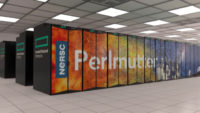Nvidia and the National Energy Research Scientific Computing Center (NERSC) debuted Perlmutter, an AI supercomputer that features 6,144 Nvidia A100 Tensor Core GPUs. Named for astrophysicist Saul Perlmutter, the supercomputer has been dubbed by Nvidia as “the fastest on the planet,” at processing with the 16-bit and 32-bit mixed-precision math used in AI applications, said the company’s global HPC and AI product marketing lead Dion Harris. Its first job will be to create the largest-ever 3D map of the visible universe.
VentureBeat reports that, “later this year, a second phase will add even more AI supercomputing power to Perlmutter, which is housed at NERSC at the Lawrence Berkeley National Laboratory.” Harris wrote that, in the first project, it will “help assemble the largest 3D map of the visible universe to date” by using its speed to process “data from the Dark Energy Spectroscopic Instrument (DESI).”

What would have taken “weeks or months on prior systems,” Harris added, will allow scientists to “accomplish the task in as little as a few days.”
At NERSC’s data and analytics services group, acting lead Wahid Bhimji said that the new supercomputer “represents a very real milestone.” “AI for science is a growth area at the U.S. Department of Energy, where proof of concepts are moving into production use cases in areas like particle physics, materials science, and bioenergy,” he said, stating that Perlmutter’s features are “well timed to meet this need for AI.”
NERSC’s “approximately 7,000 supported researchers” will have “access to four exaflops of mixed-precision computing performance for AI-assisted scientific projects” with Perlmutter.
The DESI mapping project, in addition to the universe map, “aims to shed light on dark energy, the mysterious physics behind the accelerating expansion of the universe,” said NERSC data architect Rollin Thomas. In addition to DESI, researchers plan to work “in fields like climate science, where Perlmutter will assist in probing subatomic interactions to discover green energy sources.” To do so, it will “generate simulations of atoms interacting” thanks to Perlmutter’s “special blend of AI and high-performance computing (HPC).”
“Traditional supercomputers can barely handle the math required to generate simulations of a few atoms over a few nanoseconds with programs such as Quantum Espresso,” said Harris. Dr. Saul Perlmutter, still a working astrophysicist at Berkeley Lab, “was awarded the 2011 Nobel Prize for Physics for his contributions to the discovery of dark energy.”
Nvidia, in its blog, states that, “more than two dozen applications are getting ready to be among the first” to use Perlmutter. Regarding the DESI map, it notes that, “researchers need the speed of Perlmutter’s GPUs to capture dozens of exposures from one night to know where to point DESI the next night.”
Thomas explained that the researchers have gotten “20x speedups” in their preparatory work. Software is also a “strategic component of Perlmutter,” and includes “support for OpenMP and other popular programming models in the Nvidia HPC SDK the system uses” as well as RAPIDS open-source code for data science on GPU that will “speed the work of NERSC’s growing team of Python programmers.”
Hewlett Packard Enterprise engineers helped assemble Phase 1 of the system, the company reveals, “collaborating with NERSC staff who upgraded their facility to accommodate the new system.”

No Comments Yet
You can be the first to comment!
Sorry, comments for this entry are closed at this time.